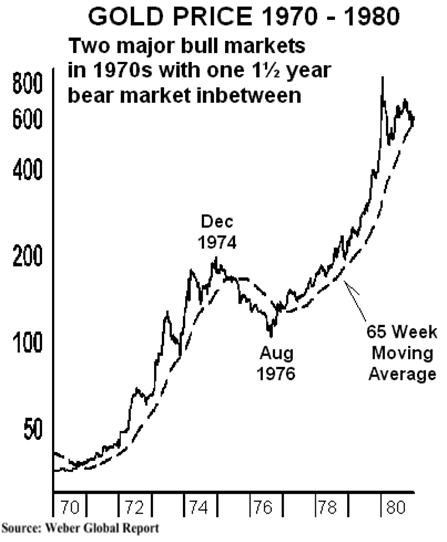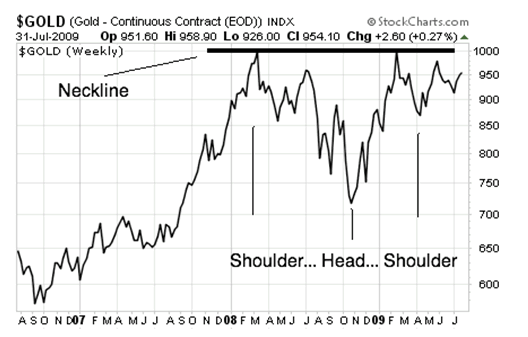Why Gold Could Breakout to $1,300 by End of 2009
Commodities / Gold & Silver 2009 Aug 03, 2009 - 02:28 AM GMTBy: Graham_Summers
 Gold may be nearing its next major leg up.
Gold may be nearing its next major leg up.
No investment ever goes straight up or straight down. During the last bull market in gold, the precious metal rose 2,329% from a low of $35 in 1970 to a high of $850 in 1980. However, during that time, there was a period of 18 months in which gold fell nearly 50% (see the chart below).
As you can see, from mid-1971 to December 1974, gold rose 471%. It then fell 50%, from December ’74 to August ’76. After that, it began its next leg up, exploding 750% higher from August ’76 to January 1980.
Now, in its current bull market (2001 to March 2008), gold rose over 300% from $250 to a little over $1,000. And just like in the mid-70s, it began showing signs of weakness after its first big rally up to $1,014 in March ’08. At one point, it even fell to $700, a 30% retraction.
Granted, it wasn’t a full 50% retraction like the one that occurred from 1974-76. But we are experiencing a financial crisis. And gold is the most common catastrophe insurance.

If we were to go by the historic pattern of the gold market in the ‘70s, gold should experience upwards resistance for 19 months after its first peak today. Gold’s recent peak was $1,014 in March ’08 (roughly 17 months ago).
If this bull market parallels the last one, then gold should renew its upward momentum in a very serious way starting in October 2009. And this next leg up should be a major one (the biggest gains came during the second rally in gold’s bull market in the ‘70s).
The chart certainly forecasts a major move.

As you can see, gold has formed a long-term inverse head and shoulders formation (two smaller collapses book-ending a major collapse). Typically a head and shoulders predicts a massive collapse. However, when the head and shoulders is inverse, as is the case for gold today, this typically predicts a MAJOR leg up.
Indeed, any move above the “neckline” of 1,000 would forecast a MAJOR move up to $1,300 or so. Going by history, this is precisely the move we should expect: remember based on historical trends (the gold bull market of the ‘70s) gold should begin its second and largest leg up in September or October 2009.
Watch the gold chart closely over the next month or so. If gold makes a move above $980 perhaps add to your current positions. If it clears $1,000, hold on tight, cause the next leg up in this secular bull market has begun.
I’ve put together a FREE Special Report detailing an unusual means of playing the gold explosion. While most investors blindly pile into the gold ETF or buy gold bullion, this backdoor play allows you to buy the precious metal at an incredible $188 an ounce. If gold breaks above $1,000, the opportunity for triple digits gains is huge.
Swing by www.gainspainscapital.com/gold.html to pick up your FREE copy!!
Good Investing!
Graham Summers
Graham Summers: Graham is Senior Market Strategist at OmniSans Research. He is co-editor of Gain, Pains, and Capital, OmniSans Research’s FREE daily e-letter covering the equity, commodity, currency, and real estate markets.
Graham also writes Private Wealth Advisory, a monthly investment advisory focusing on the most lucrative investment opportunities the financial markets have to offer. Graham understands the big picture from both a macro-economic and capital in/outflow perspective. He translates his understanding into finding trends and undervalued investment opportunities months before the markets catch on: the Private Wealth Advisory portfolio has outperformed the S&P 500 three of the last five years, including a 7% return in 2008 vs. a 37% loss for the S&P 500.
Previously, Graham worked as a Senior Financial Analyst covering global markets for several investment firms in the Mid-Atlantic region. He’s lived and performed research in Europe, Asia, the Middle East, and the United States.
© 2009 Copyright Graham Summers - All Rights Reserved
Disclaimer: The above is a matter of opinion provided for general information purposes only and is not intended as investment advice. Information and analysis above are derived from sources and utilising methods believed to be reliable, but we cannot accept responsibility for any losses you may incur as a result of this analysis. Individuals should consult with their personal financial advisors.
Graham Summers Archive |
© 2005-2022 http://www.MarketOracle.co.uk - The Market Oracle is a FREE Daily Financial Markets Analysis & Forecasting online publication.



